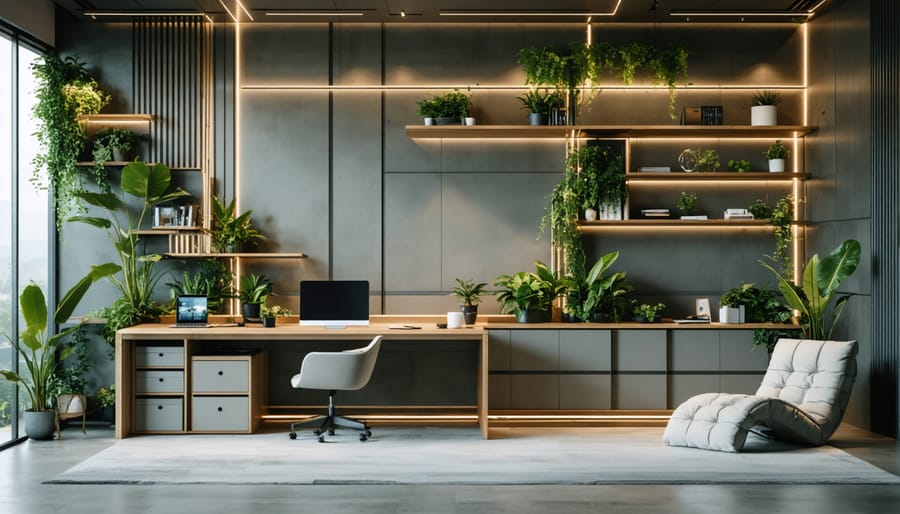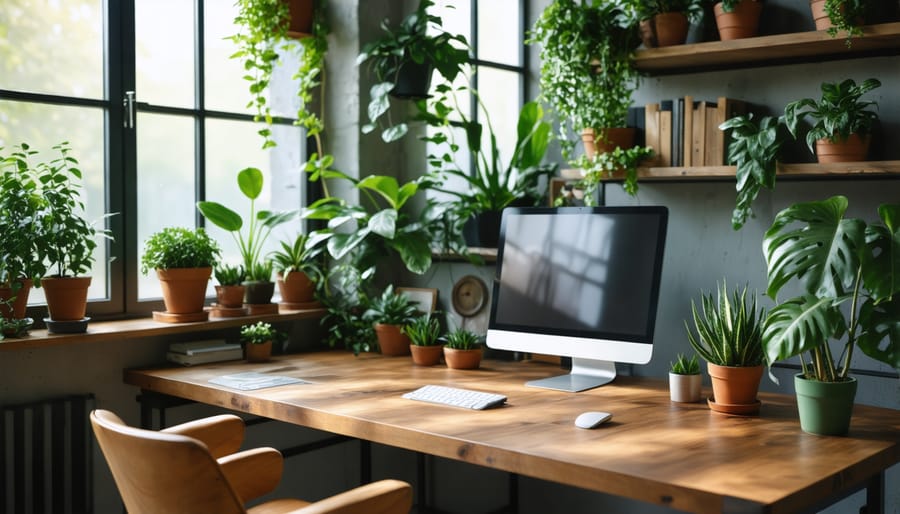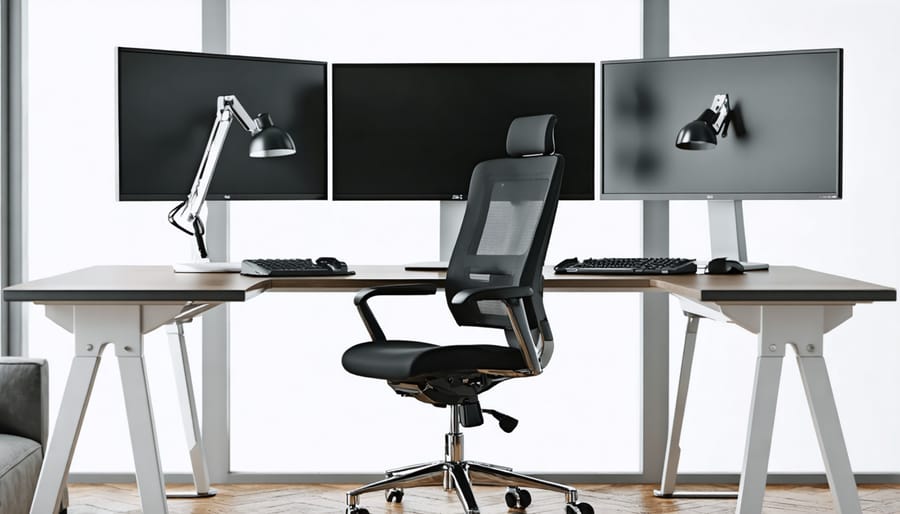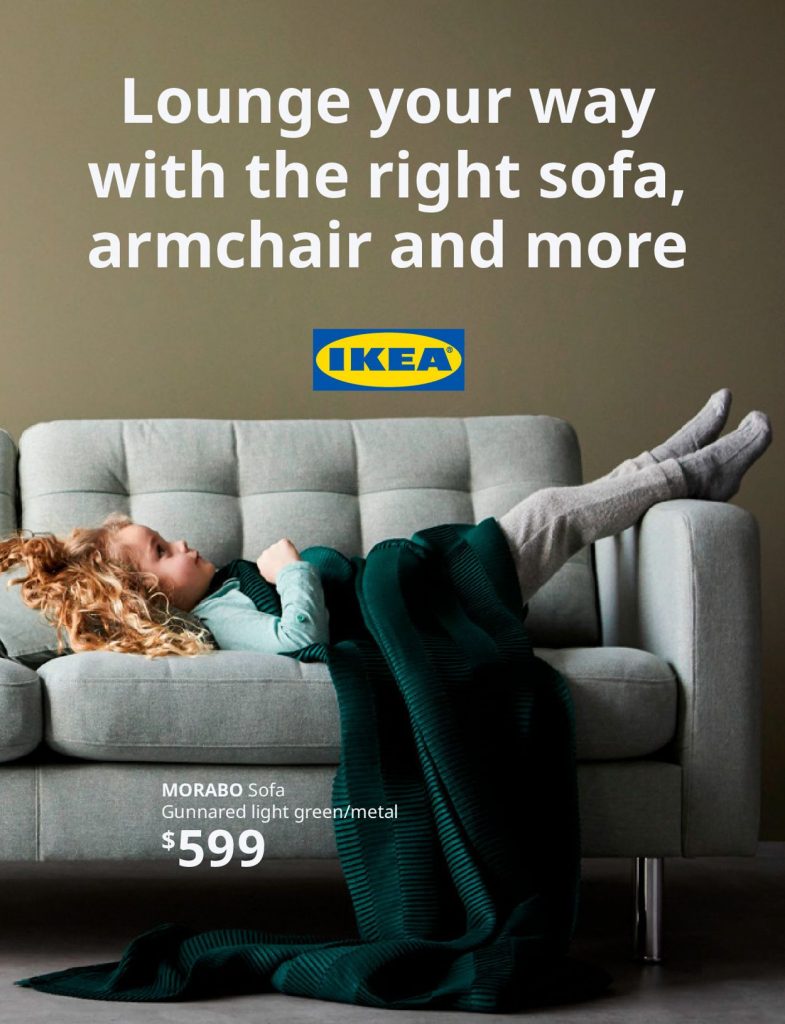
Home Office Design Trends That Actually Boost Your Productivity
Transform your living space with 2024’s most influential interior design trends, where functionality meets aesthetic innovation. The post-pandemic era has revolutionized how we view our homes, birthing a fresh wave of design approaches that prioritize both comfort and style. From biophilic elements that bring nature indoors to smart home integration that seamlessly blends technology with traditional decor, today’s interior design landscape is evolving faster than ever.
We’re witnessing a significant shift toward sustainable materials, multifunctional spaces, and personalized aesthetics that reflect individual lifestyles. Gone are the days of rigid design rules – contemporary interiors celebrate authenticity while incorporating cutting-edge trends like curved furniture, bold color blocking, and textural contrasts. Whether you’re planning a complete home makeover or seeking inspiration for subtle updates, understanding these current trends will help you create spaces that are both timeless and contemporary.
This guide explores the latest interior design trends shaping modern homes, offering practical insights into how you can incorporate these elements into your space. From color palettes that promote wellbeing to innovative storage solutions that maximize space efficiency, we’ll delve into the design elements that are defining contemporary living spaces in meaningful ways.
Multi-Functional Workspace Solutions
Transformable Furniture
The rise of compact living spaces has sparked a revolution in transformable furniture design, making it one of the hottest trends in interior design. These ingenious pieces adapt to your changing needs throughout the day, maximizing both space and functionality. Think of dining tables that convert into workstations, ottomans with hidden storage that transform into extra seating, and Murphy beds with integrated desks for the ultimate space-saving solution.
Smart modular sofas are leading this trend, featuring moveable sections that can be rearranged from a traditional setup to a sectional or even separate seating pieces. Expanding console tables are another game-changer, starting as slim hallway pieces but extending to seat up to twelve dinner guests when needed.
The latest designs incorporate advanced mechanisms and high-quality materials, ensuring smooth transitions between functions while maintaining a stylish appearance. Many pieces now feature built-in charging stations and clever storage solutions, perfect for modern living. This furniture category is particularly popular among urban dwellers and those embracing flexible living spaces, offering practical solutions without compromising on style or comfort.

Space-Saving Storage Solutions
In today’s design-conscious world, storage solutions are no longer just functional necessities but style statements themselves. The latest trend embraces multi-purpose furniture that seamlessly integrates storage while maintaining a clean, minimalist aesthetic. Wall-mounted floating shelves with hidden compartments are gaining popularity, offering a sleek look while maximizing vertical space.
Smart storage systems like modular cube organizers and expandable desk solutions allow for customization based on changing needs. Designers are incorporating built-in cabinets with push-to-open mechanisms, eliminating the need for visible handles and creating smooth, uninterrupted surfaces. Under-desk filing systems on wheels provide easy access while keeping documents out of sight.
The rise of floating furniture has introduced innovative storage solutions like suspended credenzas and wall-mounted storage units that create the illusion of more floor space. Many of these pieces feature integrated charging stations and cable management systems, addressing both storage and technology needs. Magnetic wall panels and pegboard systems offer flexible storage options that can be easily reconfigured, making them perfect for dynamic workspaces that need to adapt quickly.

Biophilic Design Elements
Natural Materials and Textures
The return to natural materials in office design reflects our growing desire to connect with nature while working. Incorporating nature-inspired elements like reclaimed wood desks, stone accent walls, and bamboo flooring creates a calming, organic atmosphere that promotes wellbeing and productivity.
Raw wood elements are particularly trending, from exposed beam ceilings to live-edge desks and floating shelves. These pieces bring warmth and character while providing durable, functional surfaces. Natural stone features, such as slate wall cladding or marble desk accessories, add sophisticated texture and visual interest to the workspace.
Woven materials like rattan and jute are making a strong comeback, appearing in office chairs, storage baskets, and decorative elements. These textural elements soften the workspace while maintaining a professional feel. Cork is another sustainable material gaining popularity, serving both as a practical bulletin board surface and an acoustic buffer.
To maximize the impact of natural materials, designers are mixing different textures and finishes – combining smooth stone surfaces with rough-hewn wood, or pairing sleek bamboo with textured grass cloth wallcoverings. This layered approach creates depth and visual interest while maintaining a cohesive, nature-inspired aesthetic.
Indoor Plants and Green Spaces
Bringing the outdoors inside has evolved from a simple design choice to a vital element of modern interior spaces. The latest trend sees a surge in “living walls” and elaborate indoor gardens, with vertical planters becoming increasingly popular in homes with limited floor space. Smart self-watering systems and automated plant care solutions make maintaining these green spaces easier than ever.
Beyond traditional potted plants, designers are incorporating preserved moss walls and botanical art installations that require minimal maintenance while delivering maximum visual impact. Large statement plants like Fiddle Leaf Figs and Monstera Deliciosa continue to dominate corners, while collections of smaller air-purifying plants create striking arrangements on floating shelves and window sills.
The biophilic design movement has inspired the integration of natural materials alongside plants, with sustainable bamboo furniture and natural stone features complementing the greenery. Plant-focused zones are being created as dedicated relaxation areas, often featuring comfortable seating surrounded by lush foliage.
For those new to plant parenthood, low-maintenance options like ZZ plants and Snake plants offer the perfect starting point, while tech-savvy gardeners are embracing smart sensors that monitor soil moisture and plant health through smartphone apps.
Tech-Integrated Design
Smart Lighting Systems
Modern workspaces are being revolutionized by smart lighting solutions that adapt to your daily routine and boost productivity. Today’s lighting systems go far beyond simple on/off switches, offering customizable settings that match your activities throughout the day.
Color-temperature adjustable LEDs are leading the trend, allowing you to shift from energizing cool light during peak work hours to warmer, more relaxing tones as evening approaches. Many systems now integrate with smartphone apps, enabling you to create personalized lighting schedules and scenes with just a few taps.
Motion sensors and automated dimming features are becoming standard additions, helping to conserve energy while maintaining optimal lighting conditions. Voice-controlled systems compatible with Alexa or Google Home make adjusting your lighting effortless, especially during video calls or focused work sessions.
The latest trend is biodynamic lighting, which mimics natural daylight patterns to support your circadian rhythm. These systems automatically adjust throughout the day, helping maintain energy levels and improve focus. For task lighting, sleek LED strips and adjustable desk lamps with wireless charging bases are gaining popularity, offering both functionality and modern aesthetic appeal.
For those concerned about installation, many new systems are wireless and battery-operated, making them perfect for renters or quick office updates without complex wiring.
Cable Management Solutions
In today’s tech-driven interiors, cable management has evolved from an afterthought to a key design element. The latest trend focuses on creating clean, clutter-free spaces where technology seamlessly integrates with your décor. Smart solutions like cable raceways that match your wall color and decorative cord covers are becoming increasingly popular, offering both functionality and style.
Modern furniture designers are responding to this need with built-in cable management features. Look for desks and entertainment centers with integrated wire channels, hidden power strips, and dedicated charging stations. Some cutting-edge pieces even incorporate wireless charging surfaces directly into their design.
Under-desk cable trays are gaining popularity, keeping wires organized and off the floor while remaining completely hidden from view. For a more budget-friendly approach, fabric cable sleeves in coordinating colors can bundle multiple cords together, creating a cleaner look that complements your room’s aesthetic.
Wall-mounted solutions are trending, with decorative cable clips and artistic wire management systems that turn necessary cables into intentional design elements. Some homeowners are even incorporating cable management into their architectural features, using crown molding and baseboards with built-in wire channels.
For a truly wireless look, consider investing in furniture with built-in power banks and cable-free charging solutions. These pieces eliminate the need for visible charging stations while maintaining the sleek, contemporary aesthetic that defines modern interior design.
Ergonomic Comfort Zones

Adaptive Seating
The latest trend in home office seating goes far beyond the traditional desk chair, embracing adaptability and ergonomic design for optimal comfort during long work hours. Modern ergonomic chairs now feature customizable settings for height, lumbar support, armrests, and tilt tension, allowing users to create their perfect seating position.
Standing desk converters and sit-stand desks have gained significant popularity, accompanied by ergonomic stools and perching seats that promote active sitting. These alternatives help maintain proper posture while encouraging subtle movement throughout the day. Ball chairs and wobble stools have also found their place in contemporary home offices, offering core engagement and improved circulation.
For those seeking comfort without sacrificing style, contemporary modular seating solutions provide flexibility for various work modes. Plush accent chairs with adequate support make excellent secondary seating options for reading or casual meetings. The trend toward multifunctional furniture has sparked innovative designs like storage ottomans that double as extra seating and meditation cushions for floor-sitting arrangements.
Smart seating with built-in charging ports and climate control features represents the cutting edge of office comfort, while sustainable materials and biophilic design elements align with eco-conscious trends.
Adjustable Workstations
The rise of flexible work arrangements has revolutionized how we think about workstations, making adjustable furniture one of the hottest trends in interior design. Height-adjustable desks are leading this transformation, allowing users to seamlessly switch between sitting and standing positions throughout the day. These versatile pieces come in various styles, from sleek minimalist designs to industrial-chic options that complement any décor scheme.
Smart desk systems now feature built-in memory settings, allowing multiple users to save their preferred heights. Many include integrated cable management solutions and wireless charging capabilities, keeping your workspace clean and organized. The most innovative models even sync with smartphone apps to remind you when to change positions.
Customizable workspace configurations are equally trending, with modular furniture systems that adapt to changing needs. Think mobile pedestals, adjustable monitor arms, and floating shelves that can be repositioned as needed. These flexible solutions are particularly popular in home offices where space optimization is crucial.
Color schemes for adjustable workstations tend toward neutral tones like whites, grays, and natural wood finishes, making them easy to incorporate into existing room designs. Many manufacturers now offer customizable finishes and accessories, allowing you to create a personalized workspace that’s both functional and aesthetically pleasing.
Color Psychology and Aesthetics
Color choices in modern interior design are shifting towards nature-inspired palettes and mood-enhancing hues that promote both productivity and emotional well-being. The latest trend embraces earthy, grounding tones like sage green, warm terracotta, and sandy beiges, which help create a calm and focused atmosphere perfect for today’s hybrid work environments.
Deep blues and rich teals are gaining popularity for their ability to boost concentration and creativity while maintaining a sophisticated ambiance. These colors work particularly well as accent walls or through textural elements like curtains and upholstery. Meanwhile, soft neutrals like warm whites, gentle grays, and subtle creams continue to provide versatile backdrops that adapt to changing design preferences.
The concept of color zoning has emerged as a clever way to define separate areas in open spaces. Using different color palettes helps distinguish between work and relaxation zones, making spaces more functional and psychologically effective. For instance, energizing yellows and corals are perfect for brainstorming areas, while calming lavenders and pale blues work well in meditation or break spaces.
Biophilic color schemes that mirror the outdoors are proving to enhance mood and reduce stress. These include forest greens, sky blues, and sunset oranges, which help maintain a connection with nature while working indoors. The key is to layer these colors thoughtfully, creating a balanced environment that promotes both focus and relaxation.
When selecting colors, consider the room’s natural light exposure and intended purpose. Current trends favor combining warm and cool tones to create dynamic, yet harmonious spaces that adapt to different times of day and various activities.
As we’ve explored, today’s interior design trends reflect our evolving lifestyles, emphasizing sustainability, functionality, and personal wellness. From the rise of biophilic design and natural materials to the integration of smart home technology and multifunctional spaces, these trends offer exciting opportunities to transform your living environment.
To get started with your own interior update, begin by identifying the elements that resonate most with your lifestyle and space. Consider incorporating one trend at a time, perhaps starting with simple changes like adding plants or updating your color scheme with earth tones. For bigger projects, create a realistic timeline and budget, and don’t hesitate to mix different trends to create a unique space that truly reflects your personality.
Remember that while trends come and go, the best interior design choices are those that enhance your daily life and bring you joy. Whether you’re planning a complete room makeover or making subtle updates, focus on creating spaces that support your wellbeing and lifestyle needs while maintaining timeless appeal. Start small, experiment with different elements, and most importantly, make your space uniquely yours.
